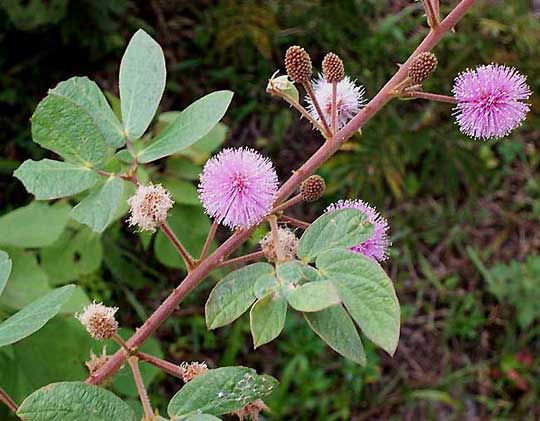Excerpts from Jim Conrad's
Naturalist Newsletter
from the November 19, 2007 Newsletter issued from Yerba Buena Clinic just outside Pueblo Nuevo Solistahuacan, Chiapas, MÉXICO
about 1740 meters in elevation, ± LAT. 17° 11' 27"N, LONG. -92° 53' 35"W
OUR SENSITIVE, ROADSIDE MIMOSA
The low, thorny, arid-land scrub forest we had in both Querétaro and the Yucatán was largely populated with diverse spiny-stemmed, feathery-leafed trees bearing powder-puff-like flower heads. These look-alike trees belonged to various Bean Family genera, foremost among them Acacia and Mimosa.
Relative to Querétaro and the Yucatán, upland Chiapas is cool and rainy, so the native forest here isn't at all scrubby. We do get spiny, scrubby vegetation, though, on deforested mountain slopes where erosion has left thin, sterile soil that loses its water as soon as it rains, thus artificially creating semi-desert conditions. Also, certain spiny, scrubby species appear along roadsides.
Along our roadsides our most common scrubby, spiny- stemmed, powder-puff, Bean Family species is shown below:

That' MIMOSA ALBIDA. Because its stems bear short spines, this is one of dozens of plants Mexicans call "Uña de Gato," or "Cat's Claw." Mimosa {Inga} alba is unusual among scrubby, spiny-stemmed, Bean Family species in that its leaves are sensitive -- you touch them and they droop and close. Several Mimosa species have touch-sensitive leaves, probably the most famous one, sold under the name of Sensitive-Plant, being Mimosa pudica. Our Mimosa alba is less enthusiastically sensitive than the Senstive-Plant, but you can indeed see its leaves drooping and closing when you touch them. Current thought is that drooping leaves are less likely to be eaten by grazing herbivores who might regard them as diseased.
Mimosa albida is also unusual among scrubby, spiny, Bean Family trees in that its leaves aren't feathery. Like other Mimosas, its blades are doubly compound (bipinnate) but instead of the first divisions forming numerous subdivisions which are themselves divided into hundreds of tiny leaflets, usually, as the photo shows, the first division just forms two subdivisions, then each of those two are divided into four leaflets. Therefore, most Mimosa albida blades have only eight leaflets, of which two are much reduced, and this makes the species very easy to identify.
In the spherical flower heads shown in the picture the pink, slender bristles are the flowers' stamens -- pink filaments atop which appear tiny, whitish, pollen-producing anthers. If you part the flower head so you can see into its interior you'll find individual tiny flowers with each flower bearing four stamens. This differentiates Mimosas from Acacias; Acacia flowers bear many stamens.
Mimosa albida is a common weed-tree throughout tropical Mexico, and far south of here.